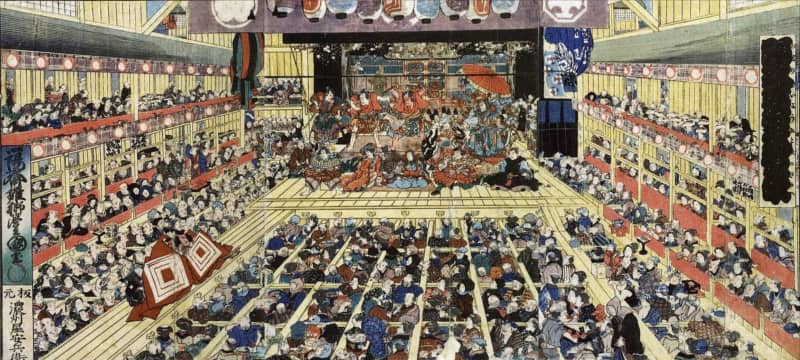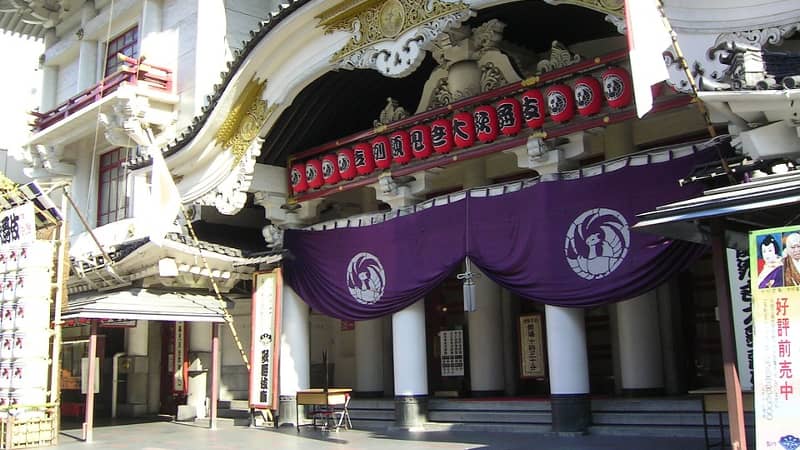If you’re planning to visit Japan and are eager to learn about its vast cultural heritage, then you should definitely include at least one Kabuki performance on your travel itinerary. The traditional dance-drama is one of the three major classical Japanese theaters, alongside noh and bunraku.
This complete guide can help you to understand the cultural meaning and significance of Kabuki, where to see a performance, what to expect from a show, and how to book tickets.
Table of Contents
What is Kabuki? History and Conventions
Kabuki theater is said to have originated during the early Edo Period in the city of Kyoto. Its founder is thought to have been Izumo no Okuni, the leader of a female dance troupe, although women were later banned from performing Kabuki. To this day, male performers known as onnagata take on female roles.
The stylized performances, extravagant costumes, and exaggerated kumadori make-up that are key components of Kabuki were further refined during the late 17th and early 18th centuries. The exaggerated movements of the actors serve to convey meaning to the audience more than the dialogue, which is delivered in antiquated language that even Japanese people struggle to understand.

Kabuki performances are usually delivered on elaborate stages equipped with unique features such as trapdoors, revolving platforms, and a footbridge called hanamichi that extends out in the audience. This latter feature allows actors to make dramatic entries and exits from the show.
Another unique element of Kabuki theater are the kurogo, stagehands dressed completely in black that move scenery and deliver props to the actors. They are intended to go unnoticed during the performance.
Kabuki shows typically tell stories of notable historical events, as well as tales of romance, heartbreak, and moral dilemmas. All of the performances are usually accompanied by music played on traditional Japanese instruments such as taiko drums and the shamisen, a type of lute.
In 2008, Kabuki was determined to possess outstanding universal value by UNESCO and was added to its Intangible Cultural Heritage of Humanity list.
Kabuki theaters: Where to watch Kabuki
One of the most renowned Kabuki theaters, Minamiza, can logically be found in Kyoto, the place where the art form originated. However, this theater typically only holds performances during a specific time period, towards the end of the year.
However, if you’re planning to visit Japan during the spring, summer, or autumn, you can head to the Kabukiza Theater in the Ginza district of Tokyo. This lively venue hosts monthly Kabuki performances throughout the year.

Another option is the Shochikuza Theater in Osaka. This performance space also often programs several runs of Kabuki shows per year.
Major Kabuki theaters in Japan
Other than those mentioned above, some of the best Kabuki theaters in Japan currently in operation include:
- Kosaka in Akita
- Meiji-za, Shinbashi Enbujō, and the National Theater in Tokyo
- Shin-Kabuki-za in Osaka
- Misono-za and Suehiro-za in Nagoya
- Kotohira Kanamaru-za in Kagawa
- Hakata-za in Fukuoka
Additionally, there are a number of historical Kabuki theaters In Japan that no longer host events, but remain open to the public as examples of traditional performance spaces. These include Kanamaruza Theater in Kotohira and the Uchikoza Theater in Uchiko.
How to watch Kabuki
All Kabuki events are performed in Japanese. However, many of the major venues offer English translation devices for an extra fee so foreign tourists can enjoy the show. These include the Kabukiza Theater in Tokyo and the Minamiza Theater in Kyoto.
Nevertheless, those unfamiliar with the Kabuki play they are going to watch are advised to read up on the plot in advance. This will allow you to focus more on the performances and the spectacle than following the English translation.
While a formal dress code is not enforced for Kabuki spectators, it is still recommended that you dress smart and wear decent footwear when attending a show.
How to get tickets
Full Kabaki performances can last up to 4 hours or more. They are divided into 2 or 3 segments that take place across the afternoon and evening, which are further divided into acts. Kabuki tickets are usually sold per segment, although some theaters also sell them by act.
If you’re planning to watch an entire segment, you can buy your tickets online and expect to pay between 3,000 and 25,000 yen per person. The price depends on the quality of the seats.
Tickets for single acts are typically only sold at the theater on the day of the performance. You can expect to pay around 2,000 yen per person for a ticket for a single act.
Famous Kabuki actors
In Japan, Kabuki actors are treated a little like movie stars. Locals may return to see the same play multiple times just to savor the performance of a particular actor. It is common practice for fans to shout out the stage name (yago) of Kabuki actors in appreciation during key parts of the show, so don’t be alarmed if you experience this!
The stage name given to a Kabuki actor is of great honor and importance in Japan. They are usually passed down through generations of an acting family, and associated with a particular theater troupe. Therefore, there is enormous pressure to live up to the yago bestowed upon an actor. They are expected to fully embody the spirit and skill of the previous owner of the name.
Kabuki actors are given their yagos in elaborate name succession ceremonies called Shūmei. These are held in front of a live audience and represent the progression of the actor into a new stage of their Kabuki career.
Famous Kabuki plays
There are 3 Kabuki plays that are particularly famous and popular in Japan:
- The Treasury of Loyal Retainers (Kanadehon Chūshingura) – Based on a famous event from Japanese history, this play tells the story of the 47 rōnin who sought revenge against those responsible for the death of their master.
- Yoshitsune and the Thousand Cherry Trees (Yoshitsune Senbon Zakura) – The story of military commander Minamoto no Yoshitsune and the end of the Genpei civil war which took place in Japan between 1180-1185 AD.
- Sugawara and the Secrets of Calligraphy (Sugawara Denju Tenarai Kagami) – Retells the life and death of famous Kyoto scholar and poet Sugawara no Michizane, whose exile is said to have resulted in a series of calamitous events in the city.
If you plan to see a Kabuki show for the first time, it’s advisable to choose one of these 3 plays for your first experience. Not only are they the most highly-regarded works of Kabuki, but it is also easy to find a plot summary of the plays online in advance so you can fully enjoy the story while watching the performance.
